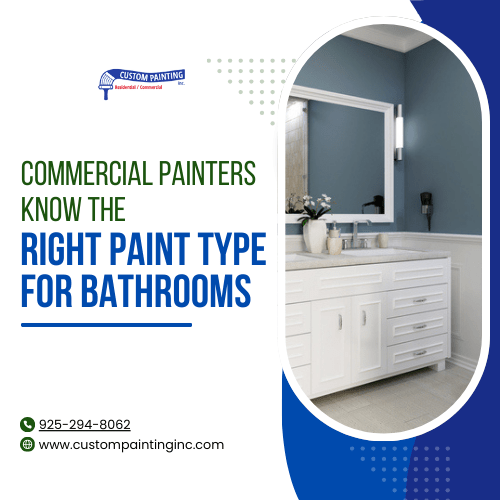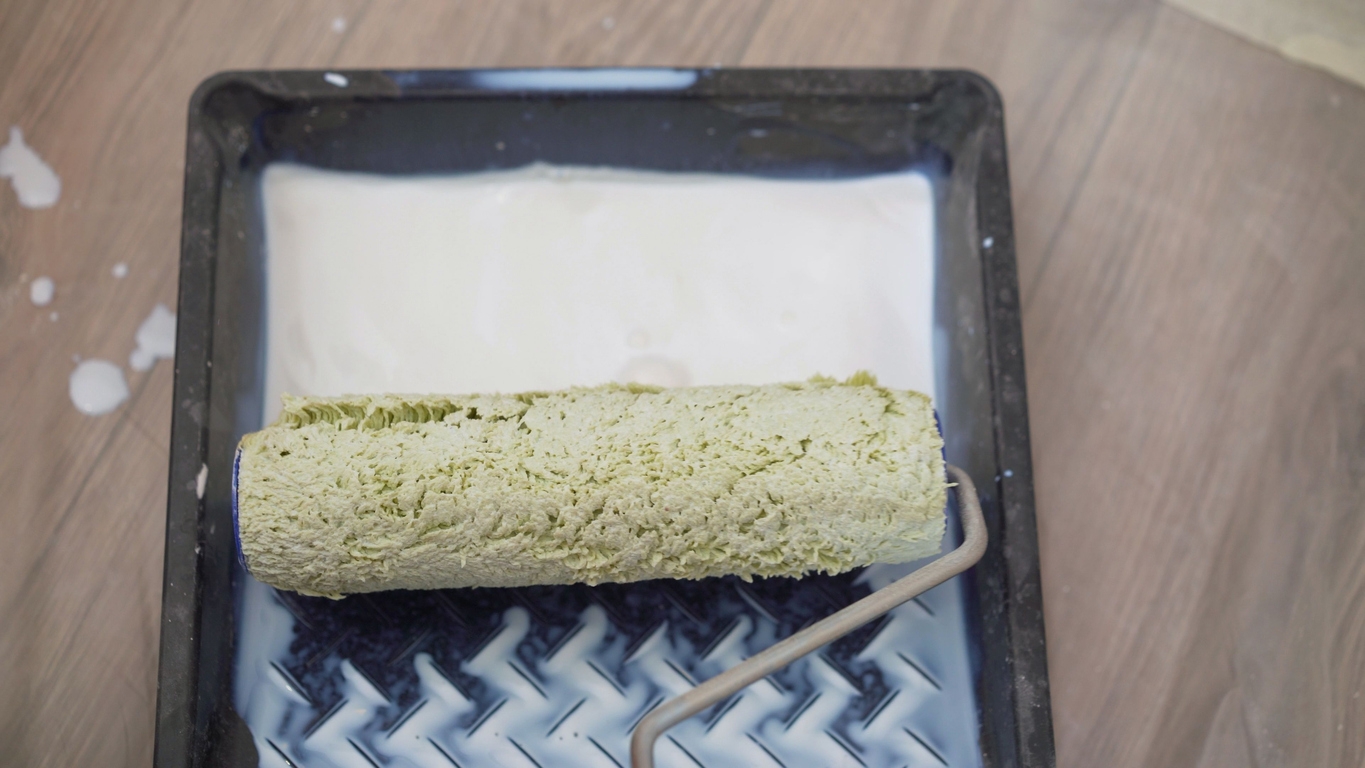Commercial painters are aware that choosing the type of paint, as well as the paint color and finish, can be challenging. That’s why care should be applied when considering what types of paint you’re going to use.
In bathrooms, there are unique considerations and challenges due to high levels of moisture and frequent temperature changes. Choosing paint for bathrooms is more than about choosing a color that matches your tiles or towel – it’s about ensuring that the paint type and finish can be durable. This is where professional painters, like those at Custom Painting Inc., become invaluable. They know exactly what works best in these environments.
What to Consider When Choosing the Best Paint for Bathrooms
Compared to painting a bedroom or living room, painting a bathroom poses specific challenges because you have to deal with moisture and humidity. Bathrooms are also typically smaller than other rooms in the house, so drying a fresh coat of paint can also be a challenge because of the apparent lack of ventilation, aside from humidity. So here’s how you can consider what kind of paint to choose for bathrooms:
1. Moisture Resistance
The bathroom is one of the most humid rooms in a house due to showers and baths. So, it’s crucial to choose paint with high moisture resistance to prevent peeling, blistering, and the growth of mold and mildew. Look for paints that are specifically formulated for bathrooms or have moisture-resistant properties.
2. Durability
Bathrooms tend to undergo a lot of wear and tear. The paint you choose should be able to withstand frequent cleaning and exposure to steam and water. Durable paints, particularly those with glossier finishes, tend to hold up better over time and maintain their finish despite cleaning and scrubbing.
3. Ease of Cleaning
Considering the type of activities that are done in a bathroom, the walls can easily get stained. Paints that allow for easy cleaning without losing their finish or color are preferable. High-gloss and semi-gloss paints are typically easier to wipe clean than matte or flat finishes.
4. Finish
The finish of the paint can affect both the appearance and functionality of your bathroom. Glossy finishes are moisture-resistant and easy to clean, making them practical, while matte finishes might suit your aesthetic preferences better but could be harder to maintain. Choose a finish that balances practicality with the interior design of your bathroom.
5. Ventilation
If your bathroom has poor ventilation, it’s particularly susceptible to mold and mildew. In such cases, choosing a paint that includes anti-microbial properties to inhibit mold growth is a wise choice. Well-ventilated bathrooms might not need paints with strong mold-resistant properties.
6. Color and Light Reflection
Does your bathroom have windows that receive natural light? Consider how the paint color will interact with light, both natural and artificial, to create the desired ambiance. Lighter colors make a small bathroom feel larger and more reflective. On the other hand, darker colors can add dramatic flair but may make a space feel smaller. Consider how the paint color will interact with light, both natural and artificial, to create the desired ambiance.
7. Health and Environmental Considerations
For those with allergies or sensitivities, opting for low-VOC (volatile organic compounds) or zero-VOC paints can be important. These paints don’t emit much harmful chemicals, improving indoor air quality and being better for the environment.
The Best Paint Types for Bathrooms
When painting your bathroom, it’s important to choose a formula that can withstand the unique challenges of a bathroom environment. These are the best types of paints for your bathroom walls:
1. Semi-Gloss and Gloss Paints
These are the traditional go-to choices for bathroom walls and ceilings because they are durable and moisture-resistant. The higher the gloss, the more moisture-resistant and cleaner the surface.
Pros:
- High moisture resistance makes them ideal for steamy bathroom environments.
- Easy to clean. Most dirt and grime can be wiped off with a damp cloth.
- Reflective properties help to brighten the space and make it appear larger.
Cons:
- It can highlight imperfections on walls, such as bumps and uneven textures.
- The shiny finish may not appeal to those who prefer a more subtle aesthetic.
2. Satin Finish
A satin finish offers a pearl-like sheen that is less reflective than gloss but still capable of handling high moisture levels. It is a great option for those who want a paint finish that strikes a balance between matte and gloss. This finish is also good for full bathrooms that experience a lot of steam and need frequent cleaning.
Pros:
- It provides a velvety sheen that works well with both artificial and natural light.
- It is more moisture-resistant than matte.
- It is easier to clean than matte finishes, though not as reflective as gloss.
Cons:
- While easier to clean than matte, it is less durable than gloss finishes under aggressive scrubbing.
- It can still show imperfections, though less so than glossier finishes.
3. Special Bathroom Paints
These are formulated specifically for bathrooms and include additives that inhibit the growth of mold and mildew. These paints are engineered to resist peeling and blistering in high-humidity environments. Manufacturers like Behr, Sherwin-Williams, and Zinsser offer products that combine paint and primer with these resistant properties.
Pros:
- Specifically formulated to resist moisture, mold, and mildew.
- It often combines paint and primer, which simplifies the application process.
- Available in a variety of finishes to suit different tastes and needs.
Cons:
- It can be more expensive than standard paints.
- Limited color options compared to general interior paints.
4. Mildew-Resistant Paints
If you’re dealing with a particularly damp bathroom or if ventilation is a concern, consider mildew-resistant paint. These paints are formulated with chemicals that prevent the growth of mold and mildew on the paint surface.
Pros:
- It contains additives to prevent mold and mildew growth.
- It is ideal for bathrooms with poor ventilation.
- Long-lasting protection keeps walls looking cleaner for longer.
Cons:
- It may have a higher chemical content due to additives, which could be a concern for those sensitive to smells and chemicals.
- Often priced higher than regular paints.
5. High-Quality Acrylic Latex Paints:
For general bathroom walls and ceilings, high-quality acrylic latex paints offer excellent durability and a good range of finish options. They are easier to apply than oil-based paints and provide a strong barrier against moisture.
Pros:
- Versatile and available in a wide range of colors and finishes.
- It is easier to apply and quicker to dry than oil-based paints.
- Resistant to fading and chalking.
Cons:
- It is not as inherently moisture-resistant as gloss finishes may require additional coatings.
- Some cheaper latex paints can be less durable and might peel in humid conditions.
6. Eggshell Finish
For those who prefer a subtle sheen, eggshells can be a viable option for bathrooms that are not excessively moist. It offers some of the easy-to-clean characteristics of glossier finishes but with a softer look that many homeowners find appealing for a bathroom setting.
Pros:
- It offers a soft, low-sheen finish that hides imperfections better than higher gloss paints.
- More moisture resistant than flat paints, suitable for less-used bathrooms.
- Provides a clean and attractive appearance with minimal light reflection.
Cons:
- It’s not as easy to clean as glossier finishes.
- It may absorb moisture in very damp environments.
The Best Colors for Bathroom Paint
Now let’s move on to the fun part: choosing a color for your bathroom! The bathroom might be a small space compared to other rooms of the house, but choosing the right color is just as important. Paint colors can help transform the space into a tranquil retreat or a vibrant area to start your day. These are the best colors to pick for your bathroom paint:
- Classic white – Classic white is the most common choice for bathrooms. It’s the most practical, too, as it gives bathrooms a brighter and bigger appearance and makes it easy to find bathroom stains. White offers a clean and fresh look and pairs well with any accent colors or materials.
- Beige – If you don’t want white, you can settle for beige. It’s also popular for bathrooms. Its soft, neutral color has a tranquil effect, subtly receding to allow furnishings and accessories to stand out while not looking as boring or cold as white. Beige is also versatile and pairs beautifully with white trim and fixtures.
- Light gray – Unlike white, light gray has a warm effect. You can use it for bathrooms of any size, whether a guest bathroom or a master bathroom. Light gray is excellent for contemporary spaces and pairs well with marble or metallic finishes.
- Pale Blue –blue works well in small bathrooms and complements white and gray accents. Plus, the blue hue adds a sense of calm and cleanliness.
- Seafoam Green – This soft, soothing color pairs well with light and dark woods and is versatile for modern and traditional styles.
- Aqua – This color adds a cheerful splash of color and pairs nicely with white and sandy tones for a beachy feel.
- Navy Blue – Navy brings depth and drama to a larger bathroom or can be used on an accent wall. It pairs well with gold or brass fixtures for a touch of luxury.
- Hunter Green – If you have a large bathroom with touches of natural wood and stone, Hunter Green is the ideal paint color to match. It creates a luxurious, lush, and enveloping feel.
- Charcoal – It offers a bold, sophisticated alternative to black without the harshness. Charcoal can serve as a dramatic backdrop for white fixtures and bright towels or accessories.
- Yellow – If you want to go a bit bold, yellow is a great choice. Yellow’s vividness makes it a great “pick-me-up” color, especially when having a warm shower in the morning. Yellow is also ideal for children’s bathrooms.
- Soft Pink – It brings a gentle, warm, feminine touch to the bathroom. Soft pinks are great for adding a hint of color without overwhelming the senses.
- Lavender – It offers a touch of whimsy and relaxation, and it also helps achieve a calming bathroom environment. Lavender pairs well with light grays and whites.
- Terracotta – It’s a warm, inviting color that adds character and coziness to any bathroom. It pairs well with natural elements like wood and stone.
- Olive green – If your bathroom has wooden accents and brass or gold fixtures, olive green can complement them to give you a modern yet earthy feel.
Conclusion
When it comes to choosing paints for the bathroom, you must take into consideration the humidity, ventilation, durability, ease of cleaning, and more. Thankfully, there are paint types that can handle these unique challenges, and you don’t have to tackle it alone. Custom Painting Inc. has the expertise to ensure that your bathroom not only looks fantastic but is also practical. With years of experience in selecting the perfect paint types and finishes for any bathroom, our professionals will provide you with a finish that lasts.
Ready to transform your bathroom? Contact Custom Painting Inc. today for a consultation, and let us help you create a space that you’ll love. Call us at 510-795-0903 or fill out our contact form.



